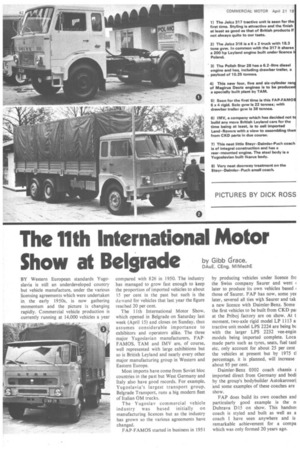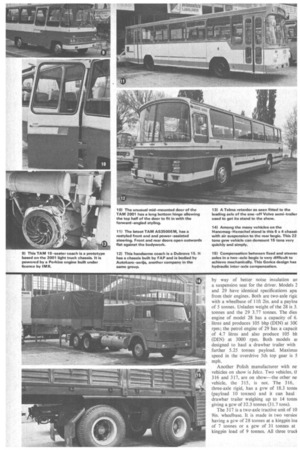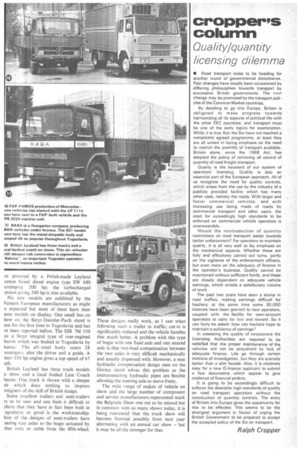The 11th International Motor Show at Belgrade
Page 40

Page 41

Page 42

Page 43

If you've noticed an error in this article please click here to report it so we can fix it.
by Gibb Grace,
DAuE, CEng, M1MechE BY Western European standards Yugoslavia is still an underdeveloped country but vehicle manufacture, under the various licensing agreements which were undertaken in the early 1950s, is now gathering momentum and the picture is changing rapidly. Commercial vehicle production is currently running at 14,000 vehicles a year compared with 826 in 1950. The industry has managed to grow fast enough to keep the proportion of imported vehicles to about 15 per cent in the past but such is the demand for vehicles that last year the figure reached 20 per cent.
The 11th International Motor Show, which opened in Belgrade on Saturday last week (April 15) and closes on Sunday, thus assumes considerable importance to exhibitors and operators alike. The three major Yugoslavian manufacturers, FAPFAMOS, TAM and IMV are, of course, well represented with large exhibitions but so is British Leyland and nearly every other major manufacturing group in Western and Eastern Europe.
Most imports have come from Soviet bloc countries in the past but West Germany and Italy also have good records. For example, Yugoslavia's largest transport group, Belgrade Transport, runs a big modern fleet of Italian OM trucks.
The Yugoslav commercial vehicle industry was based initially on manufacturing licences but as the industry has grown so the various agreements have changed.
FAP-FAMOS started in business in 1951 by producing vehicles under licence fre the Swiss company Saurer and went later to produce its own vehicles based those of Saurer. FAP has now, some yet later, severed all ties wish Saurer and tak a new licence with Daimler-Benz. Some the first vehicles to be built from CKD pal at the Priboj factory are on show. At t moment, two-axle rigid model LP 1113 a tractive unit model LPS 2224 are being hr with the larger LPS 2232 vee-engin models being imported complete. Loca made parts such as tyres, seats, fuel tanl etc, only account for about 25 per cent the vehicles at present but by 1975 tl percentage, it is planned, will increase about 95 per cent.
Daimler-Benz 0302 coach chassis E imported direct from Germany and bodi by the group's bodybuilder Autokaroseri and some examples of these coaches are show.
FAP does build its own coaches and particularly good example is the 11 Dubrava D15 on show. This handsol coach is styled and built as well as a coach I have seen anywhere and is remarkable achievement for a compa which was only formed 20 years ago. Among the FAP-designed and built icks the only newcomer is a 6 x 4 model lieh is additional to the established range. us truck, powered by a 200 hp engine, has gvw solo of 22 tons and a gew, with awbar trailer of 38 tons.
TAM has progressed from its original lochner-Humbold-Deutz engine licence in 53 to a full mutual production plan with agirus Deutz in 1972. A new 2,utz-designed range of four-, fiveand c-cylinder air-cooled engines designated L4 3R, F5 L413R and F6 L413R will produced in a new specially built factory Maribor starting later this year. When the an is complete TAM will produce all agirus Deutz in-line engines leaving agirus Deutz to produce all vec engines. rentually, in-line engines will be exported Magirus Deutz's truck plant in Germany r building into trucks for the German and her export markets. The engines, three of -Lich are on show, all have common !Grum bore and 130mm stroke mensions. The familiar Magirus insignia is st into the cylinder block but a metal tag ■ fes the place of manufacture — Maribor, tgoslavia. At the moment TAM imports agirus cabs complete but under a new reement due to start in 1973, full oduction, right down to the pressing of b panels, will begin at the Maribor tory. Z F axles and gearboxes are already oduced under licence at Maribor and fore too long a wide range of Magirus 3dels will be built.
TAM has two new coaches on show, one prototype 15-seater plus driver and guide, is based on the TAM 2001 light truck chassis and designed primarily as an hotel airport bus or for private sightseeing tours. It is completely steel-bodied and finished to a high standard both internally and externally.
The floor is completely flat front to rear except for the intrusion of the engine cover. The engine is a Perkins design built under licence by IMR in Yugoslavia. Output of the engine type no M34 /V is 61 bhp from 3.3 litres.
The other new bus is the latest version of the AS 3500 series. This one the AS 3500EM has a six-cylinder 150 hp imported Magirus air-cooled engine type F6 L413 V producing 150 bhp. Designed as a suburban bus rather than city bus it has 45 seats plus two for the driver and guide. Changes from the previous mark include a restyled glassfibre front, a new heating and ventilation system and the addition of power steering.
Industrija Motornih Vozil (IMV) is upset by the state of the economy which is affecting its production of motor cars. In 1971 the company assembled in the order of 12,000 BLMC 100 cars and had planned to expand to 16.000 units this year but instead owing to policies adopted by the Government production has stopped. Recent devaluation has caused the prices of imported parts to rise steeply yet the Government has not yet agreed to a price rise of the finished product. IMV thinks a rise of at least 20 per cent would be necessary. While the car industry is in chaos, however, the truck industry is not
quite so badly off—at least price levels have been decided and production continues normally. IMV has a steady production of one and 1.5-ton vans, type 1600, using 1622
• cc petrol engines and 1489 cc diesel Leyland engines. To make the best of the more stable commercial vehicle market IMV will be importing more built-up Land-Rovers this year. IMV hopes to start limited assembly of Land-Rovers next year, but no firm plans could be given as the all important funds for the operation have yet to he found.
Eastern bloc countries were, as usual, well represented with exhibitors from East Germany, Hungary, Russia, Czechoslovakia and Poland. Of these only Poland had any new vehicles on show and these were seen on the Pol-Mot stand. Poland's oldest factory, at StarachoWice, specializes in the production of medium-size trucks. Vehicles built here are called Star, an abbreviation of the town name.
The two basic models, Star 28 (diesel) and Star 29 (petrol), now have new cabs of improved design giving more driver comfort
by way of better noise insulation an a suspension seat for the driver. Models 2 and 29 have identical specifications apa from their engines. Both are two-axle rigic with a wheelbase of lift 2in. and a payloa of 5 tonnes. Unladen weight of the 28 is 3. tonnes and the 29 3.77 tonnes. The dies, engine of model 28 has a capacity of 6. litres and produces 105 bhp (DIN) at 300 rpm; the petrol engine of 29 has a capacit of 4.7 litres and also produce 105 bh (DIN) at 3000 rpm. Both models al designed to haul a drawbar trailer with further 5.25 tonnes payload. Maximui speed in the overdrive 5th top gear is 5 mph.
Another Polish manufacturer with ne. vehicles on show is Jelcz. Two vehicles, tt 316 and 317, are on show—the other ne. vehicle, the 315, is not. The 316, three-axle rigid, has a gvw of 18.3 tom (payload 10 tonnes) and it can haul drawbar trailer weighing up to 14 tonm giving a gew of 32.3 tonnes (31.7 tons).
The 317 is a two-axle tractive unit of 10 9in. wheelbase. It is made in two versior having a gcw of 28 tonnes at a kingpin loa of 7 tonnes or a gew of 31 tonnes at kingpin load of 9 tonnes. All three truck re powered by a Polish-made Leyland eence based diesel engine type SW 680 leveloping 200 hp; the turbocharged .ersion giving 240 hp is also available.
No new models are exhibited by the Vestern F.uropean manufacturers as might e expected but most of them have their itest models on display. One small bus on how on the Steyr-Daimler-Puch stand is een for the first time in Yugoslavia and has ot been reported before. The SIR 7M 150 as a Steyr integral type of rear-engined hassis which was bodied in Yugoslavia by karus. The all-steel body seats 28 assengers. plus the driver and a guide. A teyr 150 hp engine gives a top speed of 67 iph.
British Leyland has three truck models n show and a local bodied Lion Coach hassis. One truck is shown with a sleeper ab which does nothing to impress )reigners of the skill of British design.
Some excellent trailers and semi-trailers re to be seen and one finds it difficult to elieve that they have in fact been built in 'ugoslavia so good is the workmanship. lost of the designs of semi-trailers have :eering rear axles to the bogie actuated by ther rods or cable from the fifth-wheel. These designs really work, as I saw when following such a trailer in traffic; cut-in is significantly reduced and the vehicle handles that much better. A problem with this type of bogie with one fixed axle and one steered axle is that two-load ,compensation between the two axles is very difficult mechanically and usually dispensed with. However, a neat hydraulic compensation design seen on the Gorica stand solves this problem as the interconnecting hydraulic pipes are flexible allowing the steering axle to move freely.
The wide range of makes of vehicle on show and the large number of component and service manufacturers represented mark the Belgrade Show one not to be missed but in common with so many shows today, it is being rumoured that the truck show will become biennial possibly from next year alternating with an annual car show — but it may be all the stronger for that.












































































































